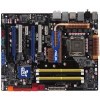- Qualcomm Launches Snapdragon 4 Gen 2 Mobile Platform
- AMD Launches Ryzen PRO 7000 Series Mobile & Desktop Platform
- Intel Launches Sleek Single-Slot Arc Pro A60 Workstation Graphics Card
- NVIDIA Announces Latest Ada Lovelace Additions: GeForce RTX 4060 Ti & RTX 4060
- Maxon Redshift With AMD Radeon GPU Rendering Support Now Available
ASUS P5Q Deluxe – P45 Is Off to a Great Start

Intel’s P45 is due out next month, but the boards are already rolling in. Our first look is at ASUS’ P5Q Deluxe, a DDR2 offering that’s feature-packed and comes in at a great price. Features include a layman’s RAID tool, updated Splashtop, lots of connectivity, a great layout and more.
Page 9 – Overclocking & Power Consumption
When I first received the P5Q, I expected amazing things with overclocking, but was surprised when I found this board didn’t keep up to the X38 and X48 boards I’ve been toying with lately. There could be a few reasons for this. One, I might have a less-than-perfect board, which is actually a good thing.
Another reason might be that P45 is not designed with the hardcore enthusiast in mind like X38 did, so 500MHz overclocks might not be all that popular. Until I am able to benchmark the Gigabyte board (when it gets here), I’ll be unable to conclude on that.

With the E8400, I was not able to go beyond 475MHz, regardless of voltages. I found this odd, though, because up to 475MHz, I didn’t have to touch voltages whatsoever. Everything was set to auto, except for the memory and CPU, which I manually set in order to keep benchmarking results accurate from board to board.
So, Northbridge at “Auto” was fine all the way up to 475MHz, but nothing after that point helped me out in the least. I traveled upwards in small increments, all the way up to 1.70v, but nothing improved stability. Talk about a hard-limit! The Northbridge was not the only voltage I altered, but it was the primary.
This was a huge contrast to what I’ve been used to. Most of the X38/X48 boards could hit 500MHz with reasonable Northbridge voltages.. but not here. So for the “ultimate” in overclocking, X38/X48 may still be the best bet.
Power Consumption
To capture power consumption, we use a Kill-A-Watt which is plugged directly into the wall, with our PC plugged into it. The monitor and speakers are plugged into a different socket, so our figures here show what our entire PC draw is and nothing else.
Please note that these figures include the Corsair Nautilus 500 water-cooling system, as it feeds off of our computers power. Only one hard drive is plugged in during this testing, and the lone accessory used is a RAM fan. The network adapters are enabled, but no LAN cable is plugged in.
We test grab figures while the machine is idle, and also when the machine is utilizing half of the CPU (QX9650). We then continue to let the 50% CPU usage continue while we load up 3DMark Vantage, to grab a realistic from normal usage. In this case, it would assume playing a game that happens to utilize the CPU well.

Our power consumption tests is where things got interesting. We knew that P45 was more energy efficient, but these differences are nothing short of substantial. We saw an average of 33W less at full load when compared to the other boards, and 13W less at idle.
Here’s where things are complicated. Is Intel’s P45 to thank for this, or does ASUS’ EPU technology also play a part? I queried ASUS about this on more than one occasion, but never received a response, so I’m somewhat in the dark.
We are still awaiting shipment of our Gigabyte P45 board, but once it arrives, we will be able to better figure out what’s causing the power improvements. It could be that Gigabyte’s DES might prove even more efficient than ASUS’ EPU… hard to say until we can pit them head to head.
But regardless of what’s causing the improvements, we saw a clear drop in overall power draw, and that’s all that matters. Hopefully boards that don’t feature EPU but do contain a P45 chipset will deliver similar results.
|
|
Support our efforts! With ad revenue at an all-time low for written websites, we're relying more than ever on reader support to help us continue putting so much effort into this type of content. You can support us by becoming a Patron, or by using our Amazon shopping affiliate links listed through our articles. Thanks for your support!





